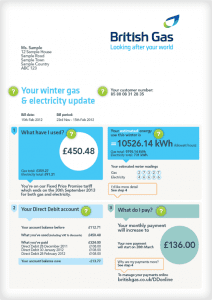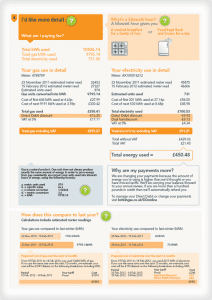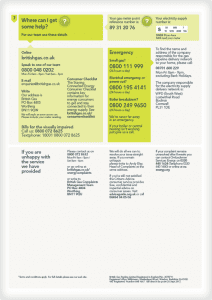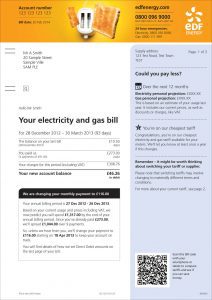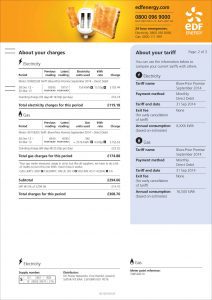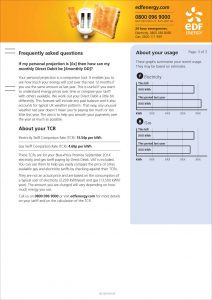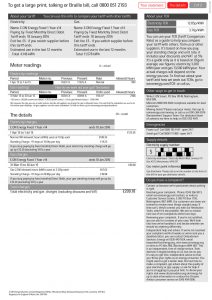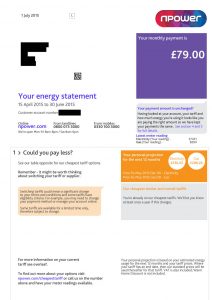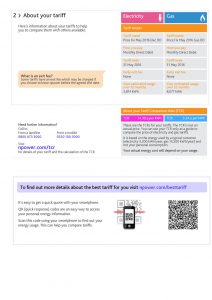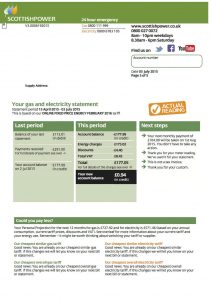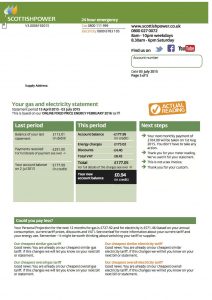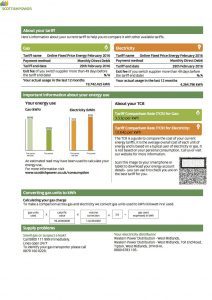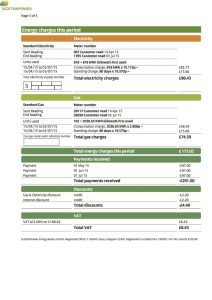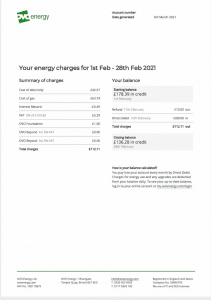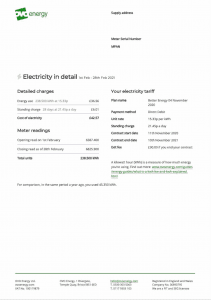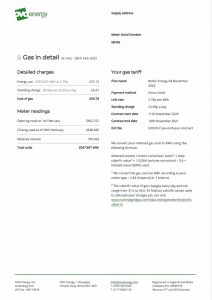Billing & Meters
Free, practical consumer advice and information on energy-related matters for the citizens of Scotland
Billing and Energy Prices
What is the Energy Price Cap?
The energy price cap sets a maximum price that energy suppliers can charge customers for each kilowatt hour (kWh) of energy they use and what the maximum daily standing charge can be.
The price cap is set by Ofgem every quarter.
The price cap may differ depending on your region and the way you pay for your energy.
Ofgem normally give an annual cost based on a dual fuel household paying by direct debit. This is to give an idea of what a typical household could pay, but every customer’s bill will be different.
The average cost between January 2024 and March 2024 is £1,928 for a typical direct debit customer.
The average cost between April 1st 2024 and June 30th 2024 is expected to be £1,660.
What do I need to do?
Each quarter when the price cap changes, you should take meter readings and provide them to your supplier. This will help your billing to be accurate and stop any estimated bills where you can end up paying for more energy than you have used.
Fixed rate tariff customers
If you have a fixed rate tariff set at a rate below the cap you will continue with that rate and your bills will not be affected, if you have a fixed rate that is higher than the cap you will again continue to pay this rate as fixed rates are not affected by the cap.
Prepayment Meter Customers
If you have a smart prepayment meter, the costs will automatically change with the price cap. If you have a traditional prepayment meter they will be updated when you top up with your key or card.
Multi-Rate Meters (e.g., Economy 7)
Suppliers have flexibility to apply slightly different discounts to the individual rates within the tariff, helping to balance-out the reduction of more expensive day rates with cheaper night-time electricity rates, so long as together, their average price does not exceed the Energy Price Cap.
(This means the day price may be higher than the cap, for example). Each supplier will approach this differently. Your supplier should communicate this to you.
Unit rates and standing charges between 1st January and 31st March 2024.
*Assumes payment via direct debit or prepayment and includes VAT (at 5%). For those who pay each month after getting a bill, it’s typically 6% higher.
| Gas | Electric |
Northern Scotland |
|
|
Direct Debit | Unit rate: 7.37p per kWh | Unit rate: 28.48p per kWh |
Pay on receipt of bill | Unit rate: 7.86p per kWh | Unit rate: 31.57p per kWh |
Prepayment | Unit rate: 7.19p per kWh | Unit rate: 28.04p per kWh |
Southern Scotland |
|
|
Direct Debit | Unit rate: 7.37p per kWh | Unit rate: 26.16p per kWh |
Pay on receipt of bill | Unit rate: 7.86p per kWh | Unit rate: 31.25p per kWh |
Prepayment | Unit rate: 7.19p per kWh | Unit rate: 28.35p per kWh |
Customer reference number
This is your identification as a customer of the supplier. The number may be required when you contact them and should be used on any correspondence with the supplier.
Period covered by the bill
This is the billing period that your bill covers. Any measurement of your energy use and cost described in the bill is for this billing time-period. This time-period will be 3 months (quarterly) unless your contract says otherwise.
Amount Owed / Balance / Amount Due
This is the amount of money that you owe for the usage during the time-period billed. This will either be a credit balance (can show as ‘CR’ or as a minus figure, e.g., £200CR), or where you owe the supplier money (debit balance – as a positive figure e.g., £200). It is important for you to check that this amount is correct and if you believe it is not, or wish to query the amount, you should contact the supplier.
Personal projection
This is an estimation of how much the current tariff will cost you over a 12-month period. The purpose of this is for you to evaluate the cost-effectiveness of your tariff and consider future energy bills. It is important to note that this is not necessarily the exact amount you will pay, only an estimation based on your previous usage.
Electricity usage / Consumption value
This is the amount of energy that that you have used during the billing period. It will be displayed in kilowatt hours. A kilowatt hour describes a kilowatt (1000 watts) being used for an hour. Working out the amount each appliance consumes/will consume in electricity can be found by multiplying the wattage of the item with the number of hours used and divide by 1000, e.g. a 100-watt appliance used for 10 hours will use 1000 watts. Dividing this by 1000 results in 1 Kilowatt hour.
Kilowatt hour formula: (appliance consumption X hours of use) ÷ 1000=kWh
E.g. (100 X 10) ÷ 1000=1 kWh
Gas usage / Consumption Value
Gas usage is measured in cubic meters or feet, with the consumption showing on the bill or statement as an ‘m’ or ‘ft’ with a small number ‘3’ next to it. ‘Cubic metres’ describes the ‘metric’ measurement and ‘cubic feet’ the imperial measurement. It is important that you understand what your meter is measuring to ensure you are being billed correctly, and this should be displayed somewhere on the meter. Smart meters may have the option for both displays. There should be a calculation showing on the bill to convert one into the other.
Estimated/actual energy usage
This confirms whether the bill is estimated or an accurate representation of your energy use. The bill will only be estimated if you are not using a smart meter or have not given a meter reading to the supplier for this billing period.
QR code
This code can be scanned by your smart phone to provide additional information on your supplier’s services (e.g. up to date rates for tariffs). The supplier’s QR code app will be needed to use this and can be found on any phone app store available to you.
Fixed term contract end date (fixed term tariff users only)
This determines the date that your fixed term tariff contract will end. This kind of tariff uses a fixed rate of energy pricing for a designated period. If you want to end the contract before this end date, consider the exit fee outlined in your contract before making a decision to end or change supply.
Breakdown of the costs
This section will explain how your bill is calculated, considering the three sources of cost:
Firstly, your energy usage cost will be calculated by multiplying the amount of energy you used (measured in kilowatt hours for electricity or cubic feet or meters for gas) by the energy price rate of your tariff. You may have a tariff with two rates, in which case both will be displayed and individually calculated.
Secondly, there is a daily standing charge that must be paid on top of energy usage costs. This must be paid regardless of energy usage and can be the reason that some consumers fall into debt with their supplier, despite using very little energy during certain periods.
Thirdly, you must pay value added tax (VAT) for the energy you purchase because it is a taxable transaction of goods and services.
Current Tariff
This section gives the name and basic details of your current tariff. If you are unsatisfied with your tariff, it would be worth researching alternative options and/or contacting your energy supplier to discuss this.
Exit fee
This is the amount that will be owed if you choose to leave your current tariff before its end date.
Payment method and billing interval
This shows how often you will be billed. This can be once every 3 months (quarterly) or monthly, but you should check your contract if you have any doubts. It also displays whether you have a credit or prepaid meter and the payment method (e.g. direct debit).
Previous and current meter readings
This section is a display of two-meter readings, each with a date. One is what your meter reading was at the end of your previous billing period and the other was the energy meter reading at the end of your current billing period.
Meter reference number
This is the number that is used to identify your energy meter. This number is essential if you wish to find out who your supplier is or to change your supplier.
You can get more information on reading an energy bill, as well as examples by downloading our factsheet by contacting us directly.
Who is responsible for the energy bill?
There are ways for you to find the person responsible for paying an energy bill, the first of which is to check who is named on the bill. The person named on the bill will be responsible for the costs unless you are a tenant.
Can a landlord charge a tenant for energy?
Your landlord can only charge you for energy if you are not paying the energy bills directly to the supplier. If energy costs are paid to the supplier by the landlord, they can only charge for the units of energy you have used, your share of the standing charge and the VAT. If an estimation of energy units used needs to be made, the landlord must be accurate in their reading of the meter. It is possible for you to take your landlord to the housing tribunal if overcharges occur.
What do I do if my landlord hasn’t paid the energy bills?
As a tenant, you can’t be deprived of any service that is needed to use the rented property as your home. This means that the landlord can’t deprive you of energy if you rent your home. If your landlord has not paid their energy bills, contact the supplier, explain the situation and request that disconnection be postponed if the supplier has given warning. You can also request that the supply be put in your name instead, allowing costs to be paid directly to the supplier instead of the landlord. Alternatives are to take legal action against your landlord or to contact the local authority on the matter.
Is the price of my energy capped by the energy supplier?
If you are on a prepayment meter or on a standard variable tariff (prices change depending on the market) or a default tariff (a tariff not chosen by you), there is a price cap on energy. This an automatically applied limit on the amount that can be charged but this applies to the rate and not to the amount being used (i.e. more usage still leads to a higher price). The caps on energy prices will vary based on your location and meter type.
The levels of price cap can be found by visiting:
https://www.ofgem.gov.uk/energy-price-caps/levels-energy-price-caps
I am in credit with my energy supplier – how do I claim this back?
If you overpaid for energy by direct debit, you will be in credit and entitled to any payment over the correct amount. This usually happens when the bill is estimated, and you end up using less than expected. The supplier may reduce your monthly payments to cover what you are owed or refund you at the end of the year. However, it may be necessary to claim your credit back from the supplier.
In order to do this, you should contact the supplier directly. You might also need to provide a current meter reading for the refund to be approved. It might be preferable to keep the credit on your account to reduce bills for future months with higher costs, especially heading into the winter months. If the supplier refuses to refund your credit or reduce bills to cover overpayment, you can make a complaint to them directly.
Should my energy supplier inform me of any price increases?
If an energy supplier is increasing their prices, they have an obligation to give you a reasonable amount of notice before it is put in effect. The exceptions to this requirement are staggered tariffs (where the prices change on set dates that you were previously informed about) and tracker tariffs (where prices change on a regular basis). If you want to avoid price increases, it is wise to compare different tariffs. If you change tariffs or suppliers, the transfer must be completed by the new or current supplier within 20 working days of the request.
What are dynamic teleswitched (DTS) meters?
A dynamic teleswitched (DTS) meter is an uncommon type of energy meter that gives different electricity prices at specific times or in proportion to the amount of energy being used by others. Not all suppliers use DTS meters and it is best to compare them alongside alternative non-DTS tariffs when deciding whether to use one. Removing a DTS meter is considerably expensive. You should find the exact cost of installation and removal before deciding to use one. You can do this by contacting your supplier.
The expected layout of energy bills that you receive will vary in style, presentation and length depending on your energy supplier. All energy bills will ultimately display the same information but will do so in different ways. It is important to remember that this information may be in a different order and named differently than presented, depending on the supplier.
British Gas
EDF Energy
EON
Npower
Scottish Gas
Scottish Power
OVO
If you feel that you are paying more than you should for energy or are struggling with your bills, contact your energy supplier to negotiate a better deal.
If the supplier will not provide you with a better deal, search for another supplier and/or another tariff.
If you have been making payments to your landlord for energy bills and they have not been paying, you cannot be chased for the debt if it is not in your name.
If the account is in arrears, then the energy company may consider disconnecting the supply.
If you are in a position where disconnection has been threatened, you can request that the supply is switched into your name.
You should outline your concerns to the energy provider in writing, supplying evidence that you have been making payments to the landlord for utility bills with your rent (copies of bank statements paired with tenancy agreement will suffice).
If you have been disconnected already, you should also contact the energy supplier and discuss the situation with them.
Being transferred to a new supplier can sometimes result in being charged by both the new supplier and the old supplier or administrator at the same time.
Suppliers have confirmed that this is only caused by setting up direct debit with the new supplier and should not occur if it is set up automatically by the new supplier. Ofgem has confirmed that the previous supplier or appointed administrator should not charge direct debits when direct debit payments are made to a new supplier.
How do I know if I am being charged twice for energy?
Review recent bank statements and check if you have been billed twice for energy. You should account for any payments towards the old supplier to settle your final bill.
What should I do if I am charged by two suppliers?
Firstly, you should cancel any payments you are making to the old supplier. Ofgem has confirmed that their safety net will allow customers to receive any credit they are owed from the old supplier or administrator. You should contact the new supplier and explain the situation. They should arrange for any payments made to the old supplier to be returned to you. This requires them getting in contact with the old supplier and may take several months to complete.
A faster way to get money back from an old supplier is to use the Direct Debit Guarantee Scheme. This will ensure that a full refund is received without delay if any errors have been made. This can be done by contacting your bank or building society.
Energy Meters
Taking a meter reading
It is important for your energy supplier to be able to provide you with accurate bills, and to do this, they may be required to take a meter reading. You can supply this yourself, very often through your energy account online, or by contacting your supplier by telephone.
Reading a meter depends on the type of meter in the property. Newer meters will have the readings displayed in digital format, with others showing the digits individually (possible on dials).
What if I have a smart meter?
A smart meter will automatically send readings to your energy supplier.
Single rate digital electricity meter
This meter has 5 white numbers with a black background and 1 or more red numbers next to them with a white background.
Write down the first 5 numbers from left to right and then ignore the red ones.
Two rate digital electricity meter
This meter has 2 sets of numbers. Each has 5 numbers with a black background and one or more red numbers next to them with a white background.
Write down the first five numbers from each set, reading each of them from left to right. Then ignore the red ones.
Two rate single display electricity meter
This meter has 2 sets of numbers representing each rate. The display may flash each one intermittently or require a button to be pressed to switch between displaying each rate.
Write down the 5 numbers from each rate.
Dial electricity meter
This meter has 5 or more dials. The first five on the left have numbers ranging from 1 to 10. There may be red dials, or a dial marked “1/10” to the right of them.
Write down the number displayed on the first 5 dials from left to right. Ignore red or 1/10 dials.
Digital Metric Gas Meter
This meter displays 5 numbers followed by decimal point followed by more numbers.
Write down the first five numbers from left to right.
Ignore any numbers after the decimal point.
Digital Imperial Gas Meter
This meter has 4 black or white numbers on the left side and 2 red numbers next to them.
Write down the 4 black or white numbers from left to right and ignore the red numbers.
Dial gas meter
This meter has 4 or more dials that have numbers from 1 to 9.
Write the numbers displayed on the first 4 dials from left to right.
If the pointer is between 2 numbers, write down the lower one. The exception is when it is between 9 and 0, when 9 should be written.
Problems Taking a meter reading
It is not always possible to get a meter reading yourself. This can be due to issues with the meter being too far out of the way, or too high up to reach, or due to accessibility issues where you can’t get to it yourself.
Your energy supplier should be able to help you if this is the case. If you are in a position where you cannot get to the meter, you should contact your energy supplier to make them aware of this.
If you are experiencing difficulty in communicating with your supplier, then you can make a complaint to them directly.
There are precautions and preparations to be made if you wish to change energy supplier while moving home. You must give your energy supplier at least 48 hours’ notice before moving home and give a forwarding address to them so they can send you the final bill for the address you are leaving. In addition, you should read your meter on the day that you move to ensure that you are not overcharged in the final bill.
Once the move is complete, inform your new supplier and check the meter to ensure you are not overcharged for energy used by the previous occupant. If the new property has a prepayment meter, contact the supplier as soon as possible. This will ensure that you don’t have to pay any arrears or debt owed by a previous occupant. The supplier will send someone to remove the previous occupant’s debt from the meter, give you a prepayment meter card/key, and give you a guide explaining how the meter works.
If there is a credit meter in the new property, you should ensure you take meter readings and communicate these to the supplier as soon as possible.
You can request to switch from a prepayment to smart meter. This includes when you have just moved into a property, as well as other circumstances.
Even if you are in debt, you can ask your supplier to move you off prepayment if it is not practical or safe for you.
It might not be safe or practical for you to be on prepayment if:
- your meter is difficult for you to get to, read or top up – for example, because you are disabled, or you have a long term illness or health condition
- you need a continuous supply of electricity, for example if you use medical equipment like a stairlift or dialysis machine.
Your supplier will look at your circumstances, including:
- if they can help you top up in a different way
- if someone else can help you top up
- how close you live to a top up point
- where your prepayment meter is
- how severe your circumstances are
Your supplier should not charge you to replace your prepayment meter if it’s not safe or practical for you to use it. They also should not ask you for a deposit, as this would count as a charge.
If you do not want to switch to an old-style credit meter or smart meter, your supplier might be able to move your prepayment meter to make it easier to get to. You should ask your supplier about this.
You should ask to be put on your supplier’s priority services register. This will give you extra help with your energy supply.
It is illegal for you to move or remove your energy meter by yourself. If you wish to move your energy meter, you must contact the relevant source which depends on how far you wish to move it. If you wish to remove your energy meter, you must contact your gas/electricity supplier to do it for you.
Does the distance I wish my energy meter to be moved matter?
Yes, who you contact depends on how far the meter should be moved:
-If you wish to move your electricity meter a meter or less, contact your electricity supplier.
-If you wish to move your electricity meter more than a meter, should contact your electricity supplier. However, they may be unable to do so themselves, in which case you must contact your local distribution centre (LDC).
-If you wish to move your gas meter a meter or less, contact your gas supplier.
-If you wish to move your gas meter more than a meter, you should contact your gas supplier. However, they may be unable to do so themselves, in which case you must contact your local gas transporter.
If additional work is required, you may need to hire a registered electrician or registered gas engineer to do it.
How much will it cost to move an energy meter?
This depends on the energy supplier doing the work and the amount of work needed to safely complete the move. Your supplier should give a quote for the cost of the work. Your provider may agree to move it for free if you are a priority customer. If the provider’s costs are too high and you believe that another would do it cheaper, consider switching suppliers.
Who should I contact for my energy meter to be removed?
In most cases, removing an energy meter is immediately followed by a replacement being put in. A common example of this is switching from prepayment to credit. In which case you should consider contacting your energy supplier.
If the supplier is unable to complete the work, you must contact your local gas transporter or your local distribution centre (LDC).
If additional work is required, you may need to hire a registered electrician or registered gas engineer to do it.
How much will it cost to remove an energy meter?
This depends on the energy supplier doing the work and the amount of work needed to safely complete the removal. Your supplier should give a quote for the cost of the work. Your provider may agree to move it for free if you are a priority customer. If the provider’s costs are too high and you believe that another would do it cheaper, consider switching suppliers.
Can I change my prepayment meter to a standard meter?
-In some cases, yes you can get your prepayment meter replaced by an old-style credit meter or for your smart meter to be changed to credit mode.
-The energy provider is unlikely to agree to change your meter if you are in debt.
-The energy provider may perform a credit check on you and decide whether to allow the change based on the result.
-If you are renting the property, the landlord’s permission will be required for the meter to be changed.
Will I need to pay for my meter to be changed?
-In the case of smart meters, no charge will need to be paid for their installation or for changing an installed smart meter to credit mode.
-You may need to pay a deposit for an old-style meter. The size of the deposit will depend on how much a household uses in energy over a 3-month period. Typically, it will be between £150 and £300 but can potentially be larger, depending on the estimation.
-A charge may have to be paid for the removal of the old meter and the replacement with another. The “Big 6” providers (Scottish power, British Gas, EDF, E.ON, SSE and Npower) do not charge for this but smaller providers may do so.
The energy regulator Ofgem requires energy suppliers to install smart meters to every home in Great Britain. The completion date for this rollout was delayed due to the Covid-19 pandemic, and is now set as the end of 2025. The rollout requires the installation of smart metering equipment, consisting of a smart electricity meter, a smart gas meter, a communications hub and an in-home display. The Supplier is required to do this with no upfront cost to the customer.
These meters will be offered to all energy customers. It is possible for a customer to refuse the offer from their supplier to have smart meter equipment installed. However, the energy supplier will have to install smart meters if they are replacing old meters, or if it is a new property installation. An advantage of smart meters is that exclusive, and often cheaper tariffs are available on them.
If you are a tenant, you can request a smart meter if you pay the supplier for your energy directly. If you are paying the landlord, you should ask them to request the installation. There may be clauses in your tenancy that require the landlord to install a smart meter.
Smart meter readings
Smart meters are connected to a network and send information about your energy use to your supplier.
They can send this information at different intervals, and the customer has the right to decide how often.
Information can be sent:
- Every half hour
- Once a day
- Once a month
- The minimum interval is once a month
Smart meter networks
There are two ‘networks’ needed for a smart meter to run effectively; these are:
- Home Area Network (HAN)
- Wide Area Network (WAN)
The HAN connects your smart meter to the in-home display and works similarly to home Wi-Fi.
The WAN is the connection that allows your smart meter to communicate with the network.
Suppliers are only responsible for the HAN.
The WAN is the responsibility of the DCC (Data and Communications Company)
Coverage of WAN is around 99.5% of the UK, but it seems much of the 0.5% that is not covered is in Scotland.
If you cannot connect to the WAN, your supplier may still install a smart meter in readiness for WAN coverage.
They won’t install a smart meter if you are a prepayment customer, as you would be unable to top up your meter without a WAN connection.
If the customer is refused a meter or a meter does not work, it’s only the supplier’s responsibility if it is a HAN issue.
Smart meters in ‘dumb’ mode
It may be possible in exceptional circumstances to install a smart meter with the smart functionality turned off.
This means it will not send meter readings and these will have to be given manually, however it will still be connected for software updates etc.
Refusing a smart meter
If you are offered a smart meter when changing supplier, or as part of the ongoing smart meter roll out, you can refuse one in some circumstances.
If your meter is faulty and needs replaced, or has reached the end of its certified life, you cannot refuse a smart meter.
Meters can last up to 45 years but are normally certified for 10 – 15 years. As suppliers push to meet roll out targets, we are likely to see more cases of customers being informed of their meter’s certification being expired.
In these circumstances, suppliers might have stocks of traditional meters and customers can always ask, but they are able to charge for the installation of a non-smart meter.
Smart meter faults
- In home display issues
- If the smart meter is less than 12 months old and it has broken or isn’t working as it should be, the supplier should fix it or replace it free of charge
- If it was damaged by the customer, they may have to pay for a replacement
- After 12 months, the supplier doesn’t have to repair it and can charge for a new one
Suspected meter fault
If the meter breaks it needs to be replaced by the supplier in the same way an older style meter would.
If a customer suspects a problem with their meter, they need to let their supplier know. The supplier should do the following within 5 working days:
- Assess the meter to check if it’s working properly and within acceptable tolerances
- Work out what the cause of the problem is, or otherwise make sure you get your supply through a meter that’s working properly and to acceptable tolerances
- Ask if you’d like the supplier to confirm the above in writing, including any actions they’d take to ensure your supply comes through a working meter, and timescales for doing so
If the supplier receives your notification outside of normal working hours, the 5 working day timescale will run from the start of the next day.
Compensation
If the supplier doesn’t meet the above criteria, they will pay £30 compensation within 10 working days. If they fail to do that, they must pay another £30 in a further 10 working days.
They won’t pay if there’s a dispute ongoing and they don’t agree that they owe the compensation ( for instance they disagree that the meter is faulty).
The compensation is normally paid as credit onto your energy account.
Install timelines
At the moment there is nothing that can be done about slow install timelines, however if there has been poor practice e.g. engineer visits cancelled, long waits then the customer can make a customer service complaint.
What is the Smart Meter Installation Code of Practice (SMICoP)?
The Smart Meter Installation Code of Practice (SMICoP) regulates energy suppliers when installing the first smart meter for domestic and micro business customers.
The code outlines the minimum standards which suppliers and their agents are obligated to follow throughout the installation process.
Is the Smart Meter Compulsory?
No, the guidelines state that the government only requires energy suppliers to offer consumers and microbusinesses smart meters. The smart meters therefore are not a legal requirement for a consumer or microbusiness. Accepting a smart meter for your property or your microbusiness is completely up to you.
More information on smart meters (for example, how to arrange to get a smart meter installed and details about any relevant charges) can be found in the ‘FAQs about having a smart meter installed’ section within this link Frequently Asked Questions – SMICoP
What is the Purpose of the SMICoP?
The principles of the SMICoP are to ensure that customers,
- receive a high standard of service throughout the installation process, and
- understand how to use and benefit from the smart metering equipment, improving the energy efficiency of their home or business.
SMICoP aims to support the delivery of the behavioural obligations that are required to meet smart metering implementation programme (BEIS) policies. These programme policies include offering an In-Home Display (IHD), Energy Efficiency Guidance and to provide the opportunity for the Customer to have a demonstration of the Smart Metering System installed (Meters and IHD – if taken).
What are the Regulations of the SMICoP?
The Supplier Licence conditions that correlate with SMICoP are:
- Domestic: Condition 41 of the Standard Electricity Supply Licence and Condition 35 of the Standard Gas Supply Licence.
- Micro Business: Condition 42 of the Standard Electricity Supply Licence and Condition 36 of the Standard Gas Supply Licence.
What happens if a Supplier does not complete the necessary steps?
The SMICoP Code Administrator (more details on this is available in the FAQ page) will intervene and follow up the escalation process further if a SMICoP Code Members has clearly breached and failed to adhere to their obligations.
The escalation process will be enacted for participating SMICoP Code Members where:
- a qualifying Supplier has not signed up to adhere to this Code.
- a SMICoP Code Member has failed or is failing to complete the documents and return to the Code Administrator as is required under the Code.
- a SMICoP Code Member has failed to undertake any tasks that are required to be taken under the Code that are specified within the obligations.
Further information discussing each stage of the emails sent out within the escalation process can be located within Section B of the Code under 3.6 Escalation Process via this link here.
Get in Touch
Click to connect with one of our dedicated energy advisers,
available Monday to Friday, 9am to 5pm
Phone
0808 196 8660
Monday to Friday
9am to 5pm
Live Chat
function and connect with
one of our advisers
